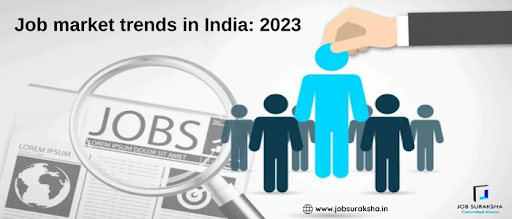Evolving preferences for Jobs in India

We know in this massive pool of job market, choosing a befitting career is hard. Researching the market, analyzing trends, estimating future scope, and then choosing the suitable career is too research-extensive and back-breaking. It gets even harder when you have a ton of professional or educational burdens on your shoulders. That is why, to take something off your plate, we have done some homework for you to bring you updates on changing market trends and evolving jobs in the market so that, without doing the labor of market research, you can opt for a career that is not only aligned to your education but is also in-demand in future.
To begin with, let us quickly look at how the student's and graduates' preferences have been influenced by changing market trends in the past so that you can better analyze the changing trends in the future.
In newly independent India, Bachelor of Science graduates reined the country for the first four decades, but something unbelievable happened in the last decade of past millennia. India, after decades of reluctance, opened its economy to foreign investments. Many companies, such as Coca-Cola, reopened their business in India. The IT and software industry bloomed and witnessed a surge in employee demand.
The market's opening was due to an imbalance in the economy, created by rising inflation and dwelling foreign exchange reserves so low it could barely meet import needs for a few days. All this happened at the dawn of the last decade of the twentieth century when the government had no option but to reluctantly open the doors for FDI (Foreign direct investment).
This is seen as a turning point in Indian history. New technology began to flood the market, further development projects were sanctioned, massive hydro projects needed installing, and every new foreign investment in India demanded a workforce-the common link- engineers.
Hence, the hunt for novel engineers began. Engineering became the most sorted-after profession. The students, greatly enamoured by Bachelor of Science, tilted towards engineering. The data fetched from the government of India depicts the gradual shift of students from medical to non-medical fields in the early 2000s. That is thirteen folds increase in the enrollment numbers from 1995 to 2007.
A similar trend was noticed in the United States also. By the end of 2010, civil and mechanical engineers were the reining jobs in the engineering segment. Moreover, these were among the highest-paying jobs with a mean annual income of $75,550, significantly high than the average US salary of $44,410.
According to Ministry of Human Resource and Development data, by the end of 2010, more than 36,000 engineering institutes mushroomed around the country, rapidly increasing yearly. By 2013, India churned 1.2 million new engineers every year, at a pace that was 100 times higher than UK, the owner of Dyson Company, Sir James Dyson, told “The Telegraph” in an interview.
How engineering went out-of-style?
However, the issue was: an imbalance in supply and demand.
When the engineering revolution began, engineers were highly in demand and fewer in number; hence, employers paid handsome salaries, and engineers gained solid reputations in society. But, as the country began to churn engineers at full throttle, their salaries and working conditions deteriorated, mostly because engineers were available far and near. Now, India produces more than 1.5 million engineers yearly, of which only 250 thousand students land relevant technical jobs. As a result, only one in five engineers remained employable, leaving 80% of graduates to rot in the dark.
The dynamic decline:
But in the past few years, the job market has been evolving, and so have higher education preferences. Delving at the success rate of engineering jobs in India, there has been a decline of a whopping 27 percent in the enrollment in B.Tech and B.E. courses since 2013-14, as per the report of AISHE.
What is in demand, then?
As per the latest reports, non-tech jobs such as writing are blowing up, and so are non-tech courses like marketing. As per search results retrieved from Google, in 2022, writing was the most sorted-after profession in India. So, this might be the right time to polish your writing skills and get that writing job you have been eyeing for so long.
On top of that, it might be the right time to commence your career with humble jobs that most people look down upon. As per the survey of job site Indeed, in December 2022, a surge in demand for non-tech jobs, such as nurses in the healthcare industry, food delivery services and education, was noticed. Additionally, marketing, the job segment that was first to take the impact of the pandemic, is back on its feet, with companies finally realizing the importance of marketing for their businesses.
Although there might be a decline in enrollment in Btech courses, there is still never-ending demand for software and IT professionals across the country. For example, data scientist, data analyst, blockchain engineer, cloud developer, digital marketing specialist and UX designer are some of the top in-demand jobs in 2023.
Other than that, as per the report of the Economic Times, there is a surge in technical course enrollment in India. It has especially become popular among non-tech employees such as bankers and government officers, who, among massive layoffs in IT sector, are trying their hands at data and AI tech. Around 40% more non-tech employees applied for technical courses.
So, you can opt for these professions, but what career options are best left in the backseat?
Don’t worry; we have compiled a list of some of India's most regretted professions so you do not end up on the same list.
The great regret:
As per the survey by ZipRecruiter, people were asked what degree they had opted for in college and if they regretted it.
Well, the results were shocking. Journalism was the most regretted college degree, and computer and IT degrees turned out to be the most regret-free degrees among the youth.
Here is the complete list of degrees that most people wish they could swap;
- Journalism: 87%
- Sociology: 72%
- Liberal arts and general studies: 72%
- Communications: 64%
- Education: 61%
- Marketing management and research: 60%
- Medical/clinical assisting: 58%
- Political science and government: 56%
- Biology: 52%
- English language and literature: 52%
While the following degrees have given people the most delight.
- Computer and Information Sciences 72%
- Criminology: 72%
- Engineering: 71%
- Nursing: 69%
- Health: 67%
- Finance: 66%
- Business Administration & Management: 66%
- Construction Trades: 65%
- Psychology: 65%
If you look at the mentioned degree courses closely, these are the same courses that yield the best market growth and pose future scopes today.
So, delving at the figures, you might have an idea of how evolving market trends narrate the demand of a profession.
The Era of Robots:
As per the study by McKinsey Global Institute, more than 30% of the global workforce will be substituted by Robots and Artificial intelligence by the end of 2030, and that is just the estimate based on present developments. By 2030, technological advancements will be better and the numbers worse.
The final thought:
To sum up, the job market is undergoing significant changes, but there is still plenty of room for growth and success. By keeping abreast of current trends and embracing new technologies and skill sets, job seekers can stay ahead of the curve and find fulfilling careers.
The rise of new industries and technologies means there are always new opportunities and challenges to overcome. Despite this, one thing remains constant: the value of hard work, dedication, and a willingness to constantly learn and grow. So, as the job market evolves, be bold and take control of your career journey. The future is full of possibilities, and you are in the driver's seat.


